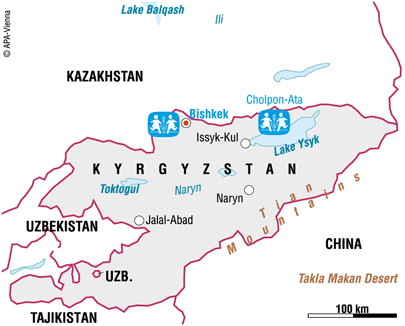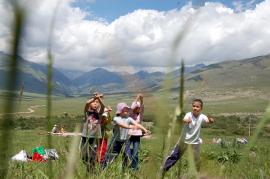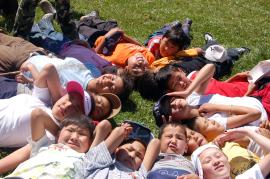
Vi er i Kyrgyzstan
Some facts about Kyrgyzstan
The years following independence were characterised by political instability as various factions fought for power. Inter-ethnic relations – between Uzbeks and Kyrgyz – continue to be tense. As a result of ethnic clashes in 2010, an estimated 300,000 people were internally displaced.
One of the most deprived countries in the region
The Kyrgyz Republic is one of the poorest countries in Central Asia. The economy was adversely affected by the collapse of the Soviet Union. The latter had provided subsidies and was the Kyrgyz Republic's main export partner. The current situation is characterised by increasing poverty rates and rising unemployment and inflation. Poor infrastructure, endemic corruption and organised crime have limited economic growth. Nearly a fifth of the population is unemployed. The percentage of the population living under the nationally-established poverty line is estimated to be 40 per cent.
Agriculture plays an important role in the Kyrgyz Republic, employing nearly half the population. The main agricultural activity is livestock raising, which produces meat, wool and dairy products. The service industry employs 40 per cent of the population and the rest of the population works in industry. In recent years the mining of gold has become a source of income.
HIV/AIDS is a growing problem, especially among some sectors of the population. The most affected groups include sex workers and injecting drug users, especially those in prisons where more than half of the inmates are addicted. The main mode of transmission had been intravenous drug use. However, the World Health Organisation reports a growing number of sexually transmitted infections.
Situation of the children in Kyrgyzstan
Children under the age of 18 represent around 35 per cent of the total population. The changing economic situation of the country has affected the lives of children: families have broken down, investment in education and support services has fallen, and the social institutions which look after the rights of children have undergone change and reform.
An estimated four per cent of children under the age of 14 are involved in forced labour. Most come from low-income families and work in a variety of settings which include manual labour and heavy industry.
Children are taken into care for a number of reasons which include: extreme poverty of the families of origin, unemployment, migration of parents in search of work, breakdown of the family, family illness, domestic violence, substance abuse or the death of the parents. Most of these children are placed in under-funded care facilities. Reports from international agencies suggest that physical violence occurs in these centres. Children who leave institutional care are not well equipped for independent living; they often end up unemployed or working in the informal economy.
Families with children with special needs and disabilities are often not provided with support; the children are usually taken away from the family home and placed in institutional facilities
SOS Children's Villages in the Kyrgyz Republic
SOS Children's Villages runs a range of programmes in Kyrgyzstan. In addition to the family-based care in SOS families, the children can attend kindergarten where high quality day-care is provided. Social centres support communities through the family-strengthening programmes which work closely with local agencies to ensure that children have access to health and education, while also providing parents with income generation and parenting skills. Given the fact that HIV/AIDS is a growing problem, advice is given to prevent children from infection. Children in Bishkek can attend the SOS Hermann Gmeiner School and young adults may move into special flats where they are guided on their path to an independent life with the help of professionals.
Website of SOS Children's Villages Kyrgyzstan
(available in Kyrgyz, Russian and English)

